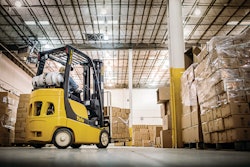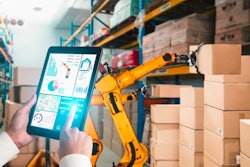
Everywhere you look, supply chains are in need of reinvention. Last year, the Food Industry Association found that 70% of retailers said supply chain issues were hurting their business — up from 42% the year before. In preparation for the 2022 back-to-school and holiday seasons, U.S. companies moved products through the supply chain over the summer to avoid the disruptions of the prior year. And according to the J.D. Power 2022 U.S. Initial Quality Study, supply chain issues led to a record rate of new-car problems, with automakers navigating shortages in creative ways.
Tracing "things” through the world’s complex supply chains is more critical than ever to driving greater efficiency, productivity, and even sustainability. Now there’s a technology that can do all that. Soon, all those products, parts and materials will communicate their supply chain journeys from manufacturer to consumer over a ubiquitous, wireless network dubbed the ambient internet of things.
A New IoT Based on Proven Tech
The tech industry has promoted so-called ambient computing for decades. It’s also established the oft-discussed internet of things (IoT). What the two have in common is billions of intelligent computing devices attached to the internet and communicating data about buildings, homes, appliances, even vehicles. Think smart speakers, fitness trackers, doorbells, robots (manufacturing and vacuuming), self-driving tractors and more.
What’s been missing until now is the innovation needed to bridge the two and make everything smart. Not just smart speakers, but smart clothes, smart packaging, smart crates, smart vaccine vials. This is the ambient IoT, a revolutionary next step in ambient computing enabling trillions of connected things, not just billions.
With ambient IoT, compute power and connectivity will be all around us – literally. A smart home won’t just include tens of IoT devices; it will contain hundreds, communicating information without intervention, without batteries, without plugging into anything. Ambient IoT forms part of the fabric of the physical world, connecting it with the digital through a few key technology enablers:
Inexpensive, stamp-sized computers. They can be affixed to anything or integrated directly into products, containers, clothes, packaging and more. Despite including advanced programming and communications, these tiny computers, called IoT Pixels, cost cents — not dollars. They can be seamlessly integrated into products and materials, connecting trillions of things to the ambient IoT.
Standards-based wireless communications. These tiny computers include wireless antennae (Bluetooth, for starters) and sensing technology that can detect and provide information like temperature, location, fill level and humidity. No purpose-built network infrastructure is required; they can communicate over standard and existing wireless devices, eventually utilizing next generation 6G wireless networks.
Ambient power. The ambient IoT is self-powered, harvesting energy from radio waves that are all around us to drive the trillions of IoT Pixels built into everything from shipping crates to vaccine vials. To date, no existing IoT or ambient computing model sources its energy this way. This ubiquitous source of energy and communication is what makes ambient IoT unique and truly transformational.
Ultimately, ambient IoT builds on the foundation of other IoT communications technologies, like RFID, but without expensive, legacy infrastructure requirements. Plus, no tapping, scanning or other human intervention. Trillions of things simply push data out over the network, rather than requiring reader devices to pull it. Ambient IoT represents real-time, continuous data communication between everything and the Internet, on its way to a powerful, AI-based cloud where companies and individuals can redefine their relationship with all those things.
Impacts of Ambient IoT
How will the ambient IoT impact everyday life? By becoming integral to everyday life. Experts at ABI Research estimates that 2.5 trillion trackable items move through the automobile supply chain every year — trackable through ambient IoT. Consider also the 600 billion parcels and packages ABI Research expects to traverse the globe by 2030, or the more than 21 billion vaccines and drug containers by 2026.
Ambient IoT makes supply chains more efficient by creating real-time visibility into the location and condition of products and materials on a unit basis. This will reduce waste, like in food chains, where supply chain inefficiency means 31% of food worldwide never gets eaten, which contributes to as much as 9% of global warming. And it contributes further to sustainability by enabling supply chain traceability and real-time emissions tracking so companies can make corrections in real-time, proactively fix operations and reduce their carbon footprint. This “in-the-moment” supply chain remediation has never been possible before.
Ambient IoT marks the transformation from inflexible supply chains to flexible demand chains. Consider clothing enriched with ambient IoT tags, continuously communicating essential details from location to usage. Soon, fashion brands won’t have to guess which of their products are worn more often; they can know. And studies have shown that such knowledge help brands better predict what consumers want, match supply to demand and reduce the 92 million tons of global clothing waste that is created each year.
Ambient IoT tags can also ensure our supply chains are legit. Counterfeit goods cost the global economy over $1.8 trillion a year. A great deal of that would be eliminated by the ambient IoT’s ability to guarantee authenticity from the source.
Ambient IoT in the Real World
Pockets of ambient IoT exist today. Already, some retailers have adopted ambient IoT in their supply chains, ensuring customers get the freshest possible food while the retailer can halve the time it takes products to go from producer to distributor to store.
Always-communicating, stamp-sized computers have been integrated into vaccine vials to trace location, temperature, authenticity and fill levels. They’ve been affixed to totes of meat and dairy — in some cases to products themselves —to monitor safe handling and supply chain logistics.
As we progress toward trillions of things communicating via ambient IoT, a broader deployment of pervasive networks will be needed to read tags and route data where it can make the most difference. Bluetooth has shown itself to be a flexible and reliable platform for ambient IoT in its earliest instances, but on its own it is insufficient for a mega-connected future. Looking ahead, inclusion in 6G cellular network standards, already in development by 3GPP, as well as future IEEE Wi-Fi standards, will make ambient IoT truly ubiquitous.
Schemes for end-to-end encryption across all networks will be needed and opt-in privacy must be built into all consumer facing traceability use cases. Like with the original IoT, it’s going to take an ecosystem of stakeholders to maximize the reach and full potential of ambient IoT.
No single company or organization can take full responsibility for ambient IoT creation and adoption, just as no single supplier can solve the car industry’s supply chain challenges. Recently, at Mobile World Congress in Las Vegas, Deloitte Chief Futurist Robert Schmid discussed the potential of ambient IoT and encouraged companies to think big, start small and scale fast. He’s right. Because when everything can communicate, the possibilities are endless.

















